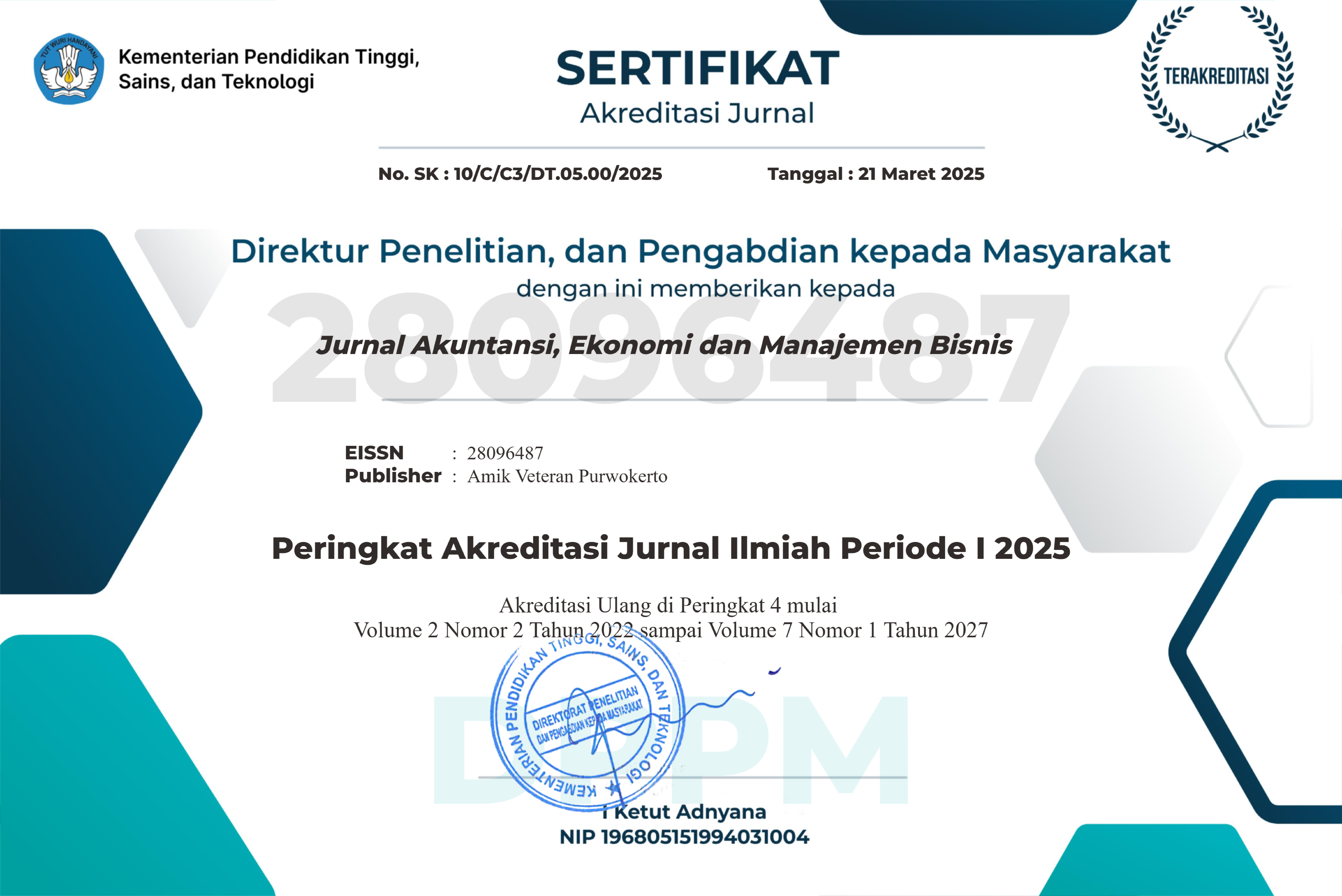Eksplorasi Pengaruh Teknologi Kecerdasan Buatan Ter-hadap Efisiensi dan Produktivitas Pegawai di RSUD Dr. Soegiri Lamongan
DOI:
https://doi.org/10.55606/jaemb.v5i2.7031Keywords:
Artificial intelligence, employee productivity, operational efficiency, health sector, Technology AdoptionAbstract
This study aims to explore the impact of the application of artificial intelligence (AI) technology on the efficiency and productivity of employees at Dr. Soegiri Lamongan Hospital. With the development of AI technology in the healthcare sector, this research is important to understand how this technology affects the quality of work of employees as well as operational productivity in hospitals. The method used was a descriptive qualitative approach with data collection through semi-structured interviews with 10 informants consisting of medical, administrative, and managerial employees. Data analysis was carried out using thematic analysis techniques to identify key patterns and themes in the interview data. The results of the study show that the application of AI at Dr. Soegiri Lamongan Hospital increases employee productivity by speeding up administrative and medical processes, as well as allowing employees to focus more on more complex tasks. Although some employees expressed concerns about job replacement, most felt more supported and efficient with the help of this technology. These findings contribute to the literature on AI adoption in the healthcare sector, by showing that AI can improve work efficiency without compromising employee psychological well-being. The conclusion of the study is that AI has great potential to improve productivity and efficiency in hospitals, with a positive impact on employee well-being. The study suggests that hospitals provide more intensive training and managerial support in implementing this technology, and proposes further research to explore more in-depth psychological factors related to the application of AI in the healthcare sector.
References
[1] Almutairi, M., Gabralla, L. A., Abubakar, S., & Chiroma, H. (2022). Detecting Elderly Behaviors Based on Deep Learning for Healthcare: Recent Advances, Methods, Real-World Applications and Challenges. IEEE Access, 10(3), 69802–69821. https://doi.org/10.1109/ACCESS.2022.3186701
[2] Aminizadeh, S., Heidari, A., Dehghan, M., Toumaj, S., Rezaei, M., Jafari Navimipour, N., Stroppa, F., & Unal, M. (2024). Opportunities and challenges of artificial intelligence and distributed systems to improve the quality of healthcare service. Artificial Intelligence in Medicine, 149(1), 1–12. https://doi.org/10.1016/j.artmed.2024.102779
[3] An, Q., Rahman, S., Zhou, J., & Kang, J. J. (2023). A Comprehensive Review on Machine Learning in Healthcare Industry: Classification, Restrictions, Opportunities and Challenges. Sensors, 23(9), 4178. https://doi.org/10.3390/s23094178
[4] Ayu Gusti, M., Satrianto, A., Candrianto, Juniardi, E., & Fitra, H. (2024). Artificial intelligence for employee engagement and productivity. Problems and Perspectives in Management, 22(3), 174–184. https://doi.org/10.21511/ppm.22(3).2024.14
[5] Bai, S., Zhang, X., Yu, D., & Yao, J. (2024). Assist me or replace me? Uncovering the influence of AI awareness on employees’ counterproductive work behaviors. Frontiers in Public Health, 12(2), 2. https://doi.org/10.3389/fpubh.2024.1449561
[6] Chandni Sawlani. (2024). E-Healthcare System for Stroke Management Using IoT and Machine Learning. Communications on Applied Nonlinear Analysis, 32(2), 157–164. https://doi.org/10.52783/cana.v32.2261
[7] Del Giorgio Solfa, F., & Simonato, F. R. (2023). Big Data Analytics in Healthcare: Exploring the Role of Machine Learning in Predicting Patient Outcomes and Improving Healthcare Delivery. International Journal of Computations, Information and Manufacturing (IJCIM), 3(1), 1–9. https://doi.org/10.54489/ijcim.v3i1.235
[8] Grote, T., & Berens, P. (2020). On the ethics of algorithmic decision-making in healthcare. Journal of Medical Ethics, 46(3), 205–211. https://doi.org/10.1136/medethics-2019-105586
[9] Habehh, H., & Gohel, S. (2021). Machine Learning in Healthcare. Current Genomics, 22(4), 291–300. https://doi.org/10.2174/1389202922666210705124359
[10] Jiang, F., Jiang, Y., Zhi, H., Dong, Y., Li, H., Ma, S., Wang, Y., Dong, Q., Shen, H., & Wang, Y. (2017). Artificial intelligence in healthcare: past, present and future. Stroke and Vascular Neurology, 2(4), 230–243. https://doi.org/10.1136/svn-2017-000101
[11] Kelley, S. (2022). Employee Perceptions of the Effective Adoption of AI Principles. Journal of Business Ethics, 178(4), 871–893. https://doi.org/10.1007/s10551-022-05051-y
[12] Kumar, R., Singh, A., Ahmed Kassar, A. S., Humaida, M. I., Joshi, S., & Sharma, M. (2025). Impact of an artificial intelligence-driven operational management system on operational efficiency in health care organization in Saudi Arabia: a mediating role of staff attitude. Frontiers in Public Health, 13(3), 1–24. https://doi.org/10.3389/fpubh.2025.1558644
[13] Magna, A. A. R., Allende-Cid, H., Taramasco, C., Becerra, C., & Figueroa, R. L. (2020). Application of Machine Learning and Word Embeddings in the Classification of Cancer Diagnosis Using Patient Anamnesis. IEEE Access, 8(2), 106198–106213. https://doi.org/10.1109/ACCESS.2020.3000075
[14] Metallo, C., Agrifoglio, R., Lepore, L., & Landriani, L. (2022). Explaing users’ technology acceptance through national cultural values in the hospital context. BMC Health Services Research, 22(1), 84. https://doi.org/10.1186/s12913-022-07488-3
[15] Moghayedi, A., Michell, K., Awuzie, B., & Adama, U. J. (2024). A comprehensive analysis of the implications of artificial intelligence adoption on employee social well-being in South African facility management organizations. Journal of Corporate Real Estate, 26(3), 237–261. https://doi.org/10.1108/JCRE-09-2023-0041
[16] Muthineni, S. R. (2025). Advancing Precision Healthcare: Machine Learning for Enhanced Diagnostics and Personalized Treatment. International Research Journal of Innovations in Engineering and Technology, 09(01), 117–128. https://doi.org/10.47001/IRJIET/2025.901015
[17] Pandey, D. L., Risal, N., & Basnet, B. J. (2023). Enhancing Productivity: Artificial Intelligence’s Effect on Productivity of Nepalese Large-Scale Organizations. Asian Journal of Economics, Business and Accounting, 23(24), 47–57. https://doi.org/10.9734/ajeba/2023/v23i241186
[18] Rafi, M., Aitken, J. M., Fatah, T. D., & Mailangkay, A. (2024). Analyzing The Impact of Generative AI on IT Employee Performance. 2024 3rd International Conference on Creative Communication and Innovative Technology (ICCIT), 1–7. https://doi.org/10.1109/ICCIT62134.2024.10701171
[19] Rahmani, A. M., Yousefpoor, E., Yousefpoor, M. S., Mehmood, Z., Haider, A., Hosseinzadeh, M., & Ali Naqvi, R. (2021). Machine Learning (ML) in Medicine: Review, Applications, and Challenges. Mathematics, 9(22), 1–11. https://doi.org/10.3390/math9222970
[20] Sinha, U., Singh, A., & Sharma, D. K. (2020). Machine Learning in the Medical Industry (pp. 403–424). https://doi.org/10.4018/978-1-5225-9643-1.ch019
[21] Suyitno, S., Wahyuningsih, Y., Elsania, A. D., & Putri, S. A. (2025). Pelatihan Interaktif Untuk Meningkatkan Literasi Digital Dan Penguatan Ekonomi Keluarga Bagi Anggota Pimpinan Ranting ‘Aisyiyah Sedayulawas, Jawa Timur. JMM (Jurnal Masyarakat Mandiri), 9(3), 2429–2442.
[22] Tang, S. (2022). Applications of Machine Learning in the Industry of Healthcare. Highlights in Science, Engineering and Technology, 1(1), 87–96. https://doi.org/10.54097/hset.v1i.432
Downloads
Published
How to Cite
Issue
Section
License
Copyright (c) 2025 Jurnal Akuntansi, Ekonomi dan Manajemen Bisnis

This work is licensed under a Creative Commons Attribution-ShareAlike 4.0 International License.








